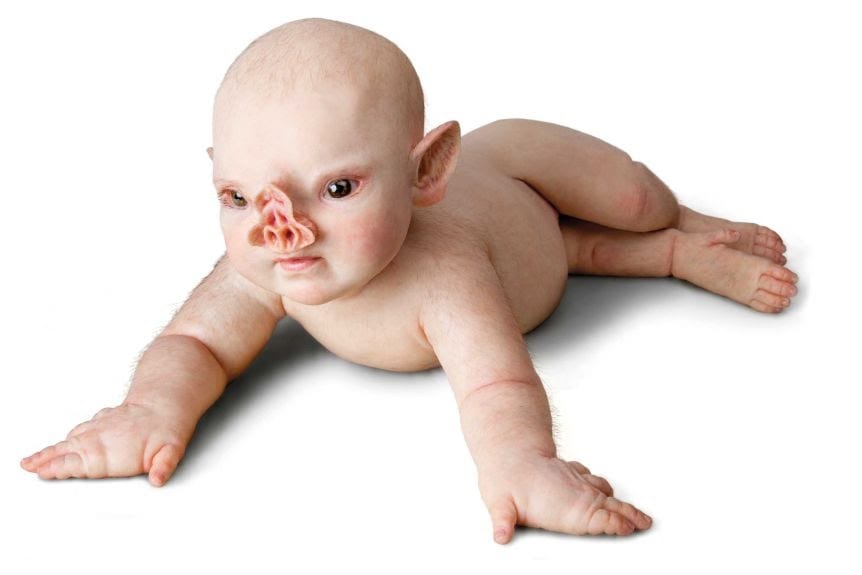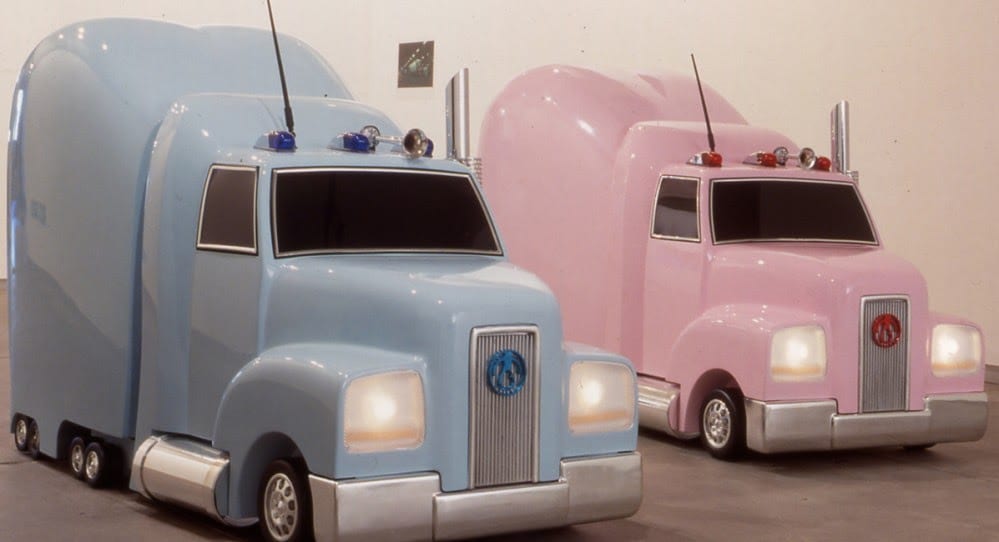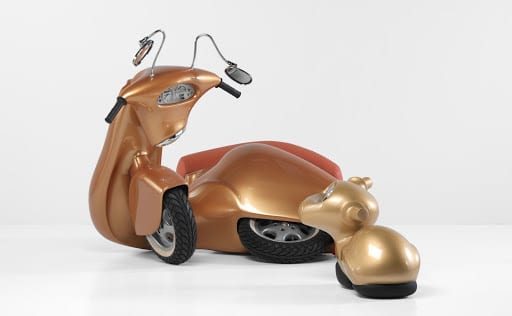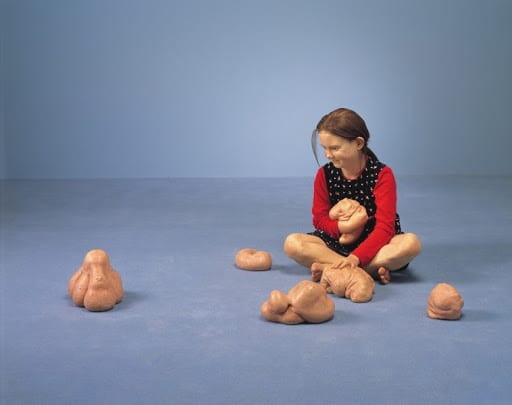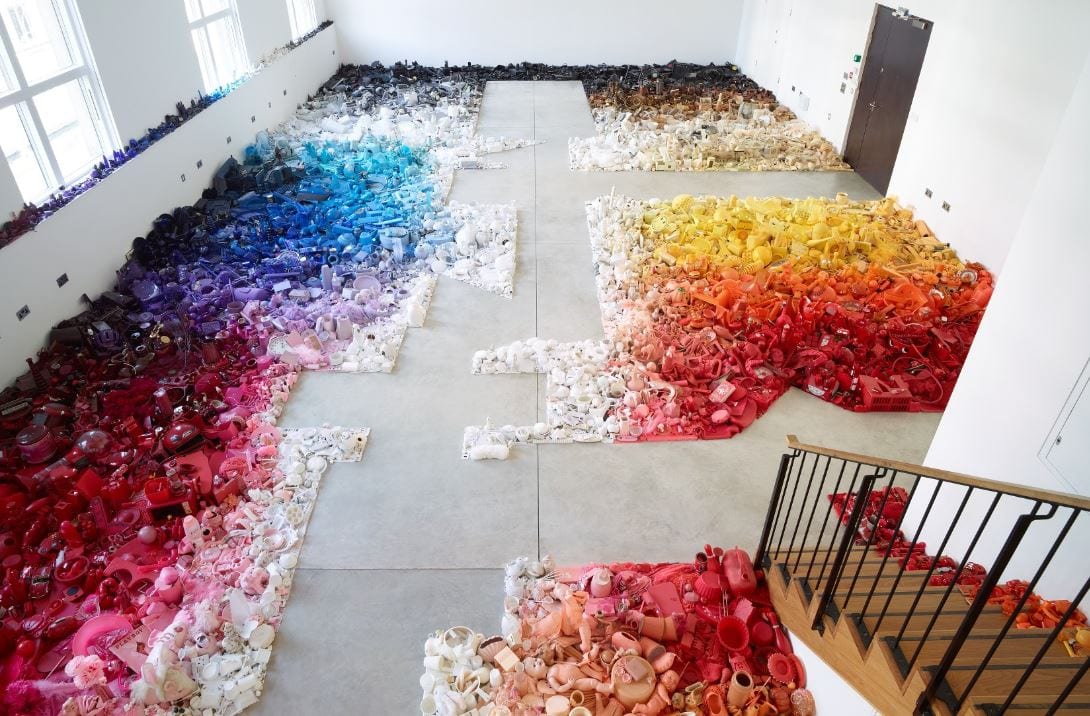The Artist Shows Extension of Non-Human Empathy in Biohacked Art
“
In a world where the cultural and the natural – the technological and organic – are ever more intermingled, this wilderness is my symbolic representation of a place where technology has become so natural that it takes on a life of its own.
”
Just a glance at Patricia Piccinini’s diverse breadth of humanoid creations imparts a disturbing, yet oddly empathetic experience. More than just sketches, detailed models or ponderings of a dystopian breed, Piccinini’s vision activates a deeply rooted human compassion.
Perhaps the disturbance stems from our appraisal of the beings, our bewilderment over sensing disgust and attachment simultaneously. Her works don’t predominantly intend to shock. They bring upon an unusually gruesome mode of comfort. Deconstructing boundaries, expanding notions of empathy, questioning the fundamental core of what makes human flesh so human.
Throughout her career, she’s retained an evolutionary homogeneity. The creatures are born from the same biological foundations. It’d be easy to imagine one trudging through our urban landscape, sliding down escalators, purchasing an ice cream and getting into a custom made car.
They’re societal, urban-centric chimeras. There is a lack of undiscovered exoticism and instead a living, breeding creature among us. An organic creation birthed within humanity.
Biohacking Connecting to Naturalized Technology
In our hierarchies, we typically place a polarizing distinction between the man-made and the natural, the organic and the non-organic, the human and the non-human. Such dualities dampen our recognition of the knotty, generational interactions occurring within our bodies. Before the advent of purposeful body-hacking, humans had already become altered from progression.
The breeding of crops modified our gastro-intestinal tract. Such effects accumulated over thousands of years, yet technological development has only accelerated in the contemporary moment. The rapidity increases the variety of applicability.
No longer are characteristics imparted onto a human. Human elements are also applied on the non-organic.We possess greater control over biological matters. Processes like genetic modifications, cloning, physical enhancement can delve into unforeseen applicability. Biotechnology opens the door to the humanization of non-organic things.
Piccinini addresses this idea through a symbol of 20th century modernisation, the personal vehicle.
While what is artificial and what is natural seems immediately obvious, when you look more closely it becomes much more difficult to tell them apart. A car would seem obviously artificial, but I would argue that it is very much more natural to me than a horse, given how much time I spend in a car. In fact, a horse is the product of millennia of human intervention in the form of selective breeding. Surely that would make it no less ‘artificial’ than the car.
Just like with our beloved animal pets, there is a sense of attachment associated with our favorite vehicles. People name their cars and occasionally devote them more sympathy than their living dependencies.
A sense of familiarity exists between man and personalized machine. In her piece Truck Babies, Piccinini examines such feelings of domestic attachment. An endearing quality evocative of the bond between mother and child.
Patricia Piccinini’s Art Taps into Cyberpunk Themes
From Deus Ex to Ghost in the Shell and even Star Wars, the idea of human-machine hybridization is nothing new. It’s been a central tenant in the cyberpunk genre for decades. Most often, the resultant hybrid resembles a human in its form. The cybernetic advancements provide an advantage in an otherwise disadvantaged society.
Piccinini’s work operates on a modified proposition of biotech implications.
She vehemently insists that her projects eschew futurism and instead focus on an alternate realism. Her cyborgs, perhaps mostly machines with only a touch of organic material or alternatively predominantly organically non-human, don’t necessarily provide an advantage to existence. With humanities foray into genetic manipulation, misfortunes of natural evolutionary processes are bound to occur. Remember, Dolly the Sheep died an untimely death.
Such processes could produce a large spectrum of beings accommodated into our umbrella of existence. The hyper-realistic characters of her work don’t concoct their own vision of dystopia. Instead and perhaps more frighteningly, they’re propositions our current societal system must prepare to embrace.
A cyborg too intimate with our ancestral instincts.
Piccinini Finds Humanistic Response through Motherly Affection
A pull on the deeply-rooted foundations of empathy. The intuitions which arrived with our birth will proliferate with genetically modified beings just the same.
Evolutionary momentum of the natural world will continue to influence stronger than our technological control. Reproduction, no matter in the circumstance of a labratorial tube or out in the wild, will consistently establish generational relationships.
The bond of mother, and child. Creator and kin. Such notions exist past our apparent human tendences, deep in our animalistic backbones.
In a dystopian technological wasteland, filled with organic, non-organic matter, beings of ever increased variety will find unforeseen routes of acceptance. Yet, they will still adhere to the same biological tenants.
To me, fertility and reproduction is the great magic of the world, take it away and we don’t have a world. Yet, there seems so little space in the art world for this extraordinary, yet so amazingly ordinary, aspect of life. It is rich and fascinating territory.
Futuristic Ideas without the Futurism
As such, Piccinini’s work rests in inclusion. In the abandonment of categorizations ofrace, sex, humanity, technology or artificiality. These terms rest on a spectrum, not a delineation. Their interplay blurring, impacting our relationship with our bodies and each other in ways not seen before.
Futuristic glances at genetic modification and bodily enhancements portray the innovations as human remedies. Problem-solving applications or medically-driven projects.
There’s no way to know what science will unfold. Perhaps only for certain is its complexity will surpass our expectations.
The compassionate approach of Piccinini’s work sets upon a trustworthy moral momentum for future bio-ethical dilemmas. No matter if some biotech progressions turn out helpful, others detrimental. If there is a possibility of new humanoids on our globe, or by chance we only modify ourselves.
A stance of acceptance, of understanding will need to be reinforced. An extension of what makes us so human, empathy, will hopefully be applied to what is not so human at all.
All artistic work credit to Patricia Piccinini

